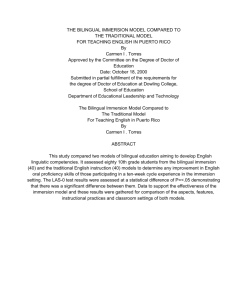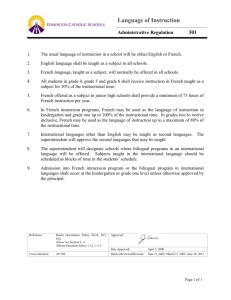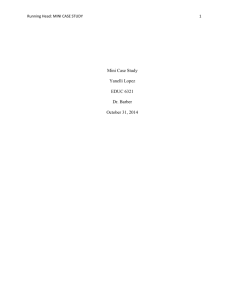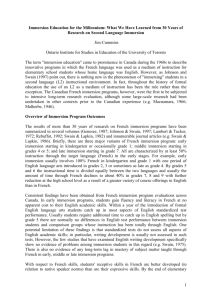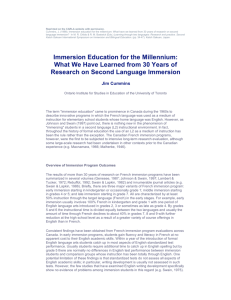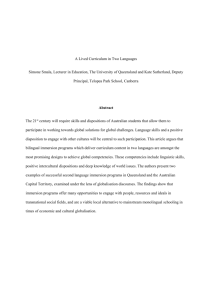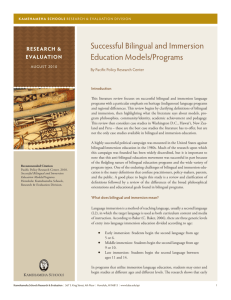File
advertisement
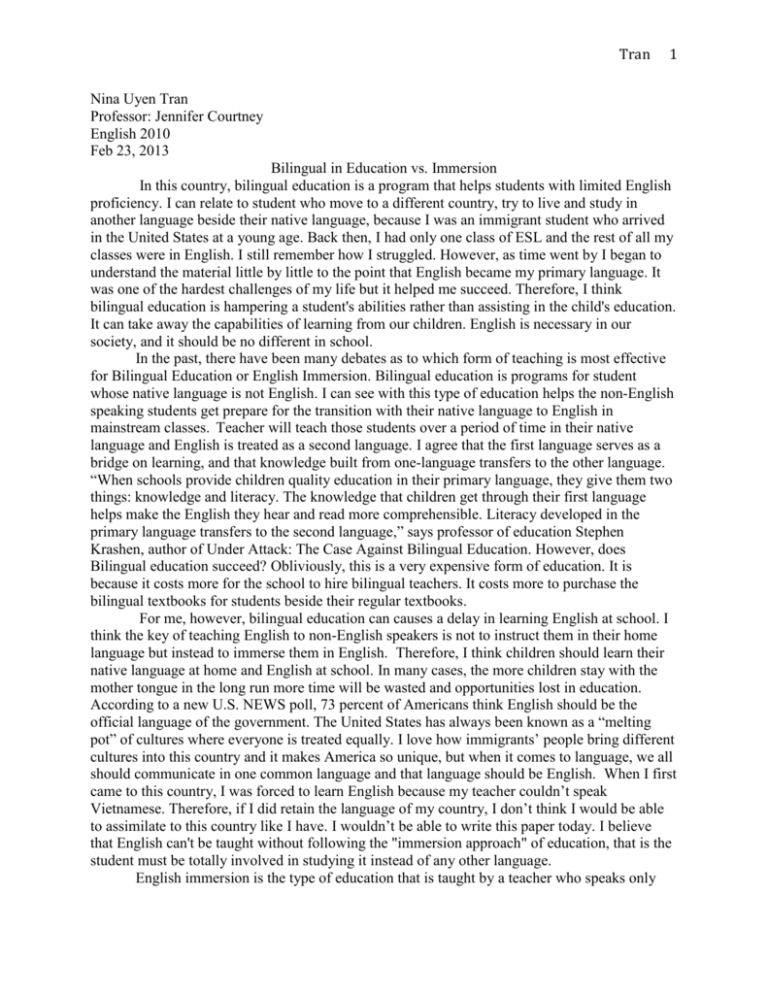
Tran 1 Nina Uyen Tran Professor: Jennifer Courtney English 2010 Feb 23, 2013 Bilingual in Education vs. Immersion In this country, bilingual education is a program that helps students with limited English proficiency. I can relate to student who move to a different country, try to live and study in another language beside their native language, because I was an immigrant student who arrived in the United States at a young age. Back then, I had only one class of ESL and the rest of all my classes were in English. I still remember how I struggled. However, as time went by I began to understand the material little by little to the point that English became my primary language. It was one of the hardest challenges of my life but it helped me succeed. Therefore, I think bilingual education is hampering a student's abilities rather than assisting in the child's education. It can take away the capabilities of learning from our children. English is necessary in our society, and it should be no different in school. In the past, there have been many debates as to which form of teaching is most effective for Bilingual Education or English Immersion. Bilingual education is programs for student whose native language is not English. I can see with this type of education helps the non-English speaking students get prepare for the transition with their native language to English in mainstream classes. Teacher will teach those students over a period of time in their native language and English is treated as a second language. I agree that the first language serves as a bridge on learning, and that knowledge built from one-language transfers to the other language. “When schools provide children quality education in their primary language, they give them two things: knowledge and literacy. The knowledge that children get through their first language helps make the English they hear and read more comprehensible. Literacy developed in the primary language transfers to the second language,” says professor of education Stephen Krashen, author of Under Attack: The Case Against Bilingual Education. However, does Bilingual education succeed? Obliviously, this is a very expensive form of education. It is because it costs more for the school to hire bilingual teachers. It costs more to purchase the bilingual textbooks for students beside their regular textbooks. For me, however, bilingual education can causes a delay in learning English at school. I think the key of teaching English to non-English speakers is not to instruct them in their home language but instead to immerse them in English. Therefore, I think children should learn their native language at home and English at school. In many cases, the more children stay with the mother tongue in the long run more time will be wasted and opportunities lost in education. According to a new U.S. NEWS poll, 73 percent of Americans think English should be the official language of the government. The United States has always been known as a “melting pot” of cultures where everyone is treated equally. I love how immigrants’ people bring different cultures into this country and it makes America so unique, but when it comes to language, we all should communicate in one common language and that language should be English. When I first came to this country, I was forced to learn English because my teacher couldn’t speak Vietnamese. Therefore, if I did retain the language of my country, I don’t think I would be able to assimilate to this country like I have. I wouldn’t be able to write this paper today. I believe that English can't be taught without following the "immersion approach" of education, that is the student must be totally involved in studying it instead of any other language. English immersion is the type of education that is taught by a teacher who speaks only Tran 2 English with their students. In these programs, students are taught to speak, read and write in English. Students don’t have to forget their native language in these programs. In 2009, according to the U.S Supreme Court ruled that structured English immersion (SEI) programs worked better than bilingual education programs. In English immersion, the main focus is for ELL students to gain their confidence at school in English language. All teachers provided for their education is in English and students are spoken to and expected to speak in English. With my personal experience, I used to spend so much time learning how to speak the language that I forgot to learn how to use the right grammar in English. “English language learners are expected to learn in English from the beginning, and their native language plays little or no role in daily reading lessons,” says Robert Slavin and Alan Cheung’s article on “Language of Reading Instruction for English Language Learners”. Yes, school is hard enough by itself already even with your own language, but without trying to achieve your goal by learning English, I don’t think school will be easier in the long run. Therefore, in an immersion strategy program, teachers will fit their English to a level that the limited English proficient students can understand. It will help students understand the material in English, plus allow students to slowly grow their English skills. The important part is that the immersion teacher does know how to speak the non-English home language, which allows him or her to determine if problems arise from language understanding or from the course content. I think the English immersion program will help non-English speaking students improve their English faster and stronger. It will build a strong foundation for their education based on their skill for English. When I came to America, I never expected people around me speak my language with me. It is really nice when people can speak my native language, but I realized the best way for me to join the society is be able to speak English fluently. I support the ideas that we should continue speaking our native language, but only as our second language. We can speak it at home, or around our native community but not in public school where you need to learn education in English. Tran 3 At the end, as I learned, both programs are trying to help non- speaking students to learn English in school. Students learn differently and have his or her own diverse struggle. These children deserve the same exact education as any other American and English immersion will help them close the gap between English leaner students and normal students. I think that, with some preparation, the English Immersion method is what brings best and fastest results for the ELL students. To be totally immersed in the language forces us to think and communicate in the target language (in this case English). So with time and with some “sinking” I believe the student start to get used to it and start to become better and better at English.
